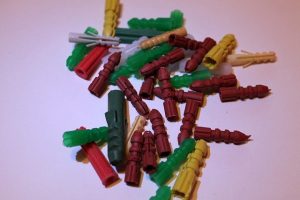
Screws are commonly used to fasten objects to walls. Whether you’re installing shelves, a coat rack, a mirror, framed pictures, etc., you may want to use a set of screws. Unfortunately, screws alone may not be sufficient. Depending on where exactly the objects are installed, drywall anchors may be required.
What Are Drywall Anchors?
Also known as drywall plugs, drywall anchors are hollow and self-expanding screw attachments that are designed to create a stronger connection between a screw and a wall. They are typically made of plastic or a similar synthetic material. As shown in the adjacent photo, drywall anchors have a hollow center. This hollow center is designed to support a screw.
How Drywall Anchors Work
You might be wondering how drywall anchors work. Screws, of course, are typically inserted directly into a wall. You may have to drill pilot holes beforehand. Regardless, when using screws to secure an object to a wall, you’ll probably drive them directly into the wall itself. There are instances, however, in which you may want to use drywall anchors.
With drywall anchors, you won’t insert the screws directly into the wall. Instead, you’ll insert them into the drywall anchors. To use drywall anchors, you’ll need to drill pilot holes. You can then place the drywall anchors into these pilot holes. Once secured, you’ll be able to insert the screws into the drywall anchors. Drywall anchors are self-expanding. When you insert a screw into a drywall anchor, the back of the drywall anchor will expand.
When to Use Drywall Anchors
Drywall anchors aren’t required for all wall-based fastening applications. If there’s a stud directly behind the wall, for instance, you probably won’t need to use them. Studs offer support for screws as well as the objects with which they are used. Of course, studs don’t encompass the entire space of a given wall. You’ll only find them every 16 to 24 inches.
You can still install objects on walls — even if there’s no stud available. You just need to use drywall anchors. Drywall anchors live up to their namesake by anchoring into drywall panels. You can push them into a pilot hole. As you tighten a screw into a drywall anchor, the drywall anchor will expand. The back of the drywall anchor will essentially expand around the back of the drywall panel. Drywall anchors simply allow screws to be used with drywall rather than studs.
